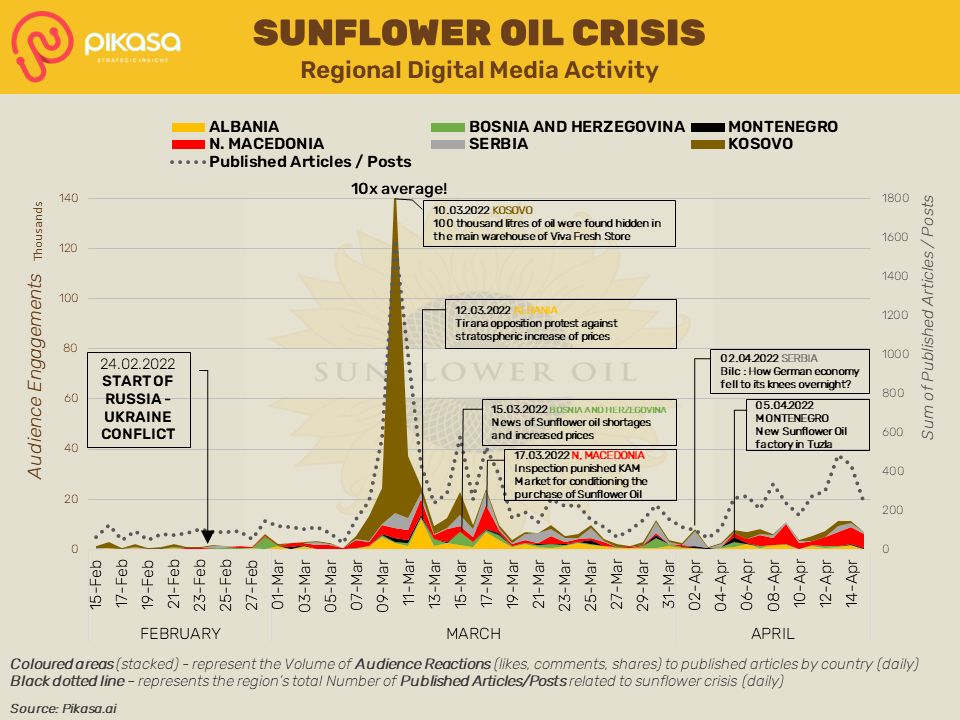
After the start of the Russia-Ukraine conflict, Sunflower oil export prices rapidly increased due to the fact that Ukraine and Russia are global leaders in the supply of sunflower oil.
In 2018/19, the share of exports of these countries covered nearly 80% of the global market. Since the start of the war, the price of sunflower oil increased 32% (from February 23 to March 1 according to S&P Global data).
This analysis presents the results from research conducted in Feb-Apr 2022 period, regarding the publishing of news, articles and posts related to the Sunflower Oil crisis in all digital media across 6 countries of the Western Balkans Region.
Through detection algorithms based on topic-specific keywords, across the WB region we were able to identify 13.769 media articles and social media posts where the Sunflower Oil crisis is mentioned, and measure 552.704 of their audience engagements and reactions (likes, comments, shares and emotions).
The INFOGRAPHIC above presents the Total Daily Volume of the published Sunflower Oil crisis-related news/articles/posts (black dotted line) and the Volume of Audience Reactions to the news for each country (stacked colored areas).
Furthermore, the events and news that elicited most of the published articles and provoked most of the public reactions in the corresponding countries, are presented on the timeline of the 15 Feb – 15 April period.
Across WB countries, Kosovo on 10th of March had notably the highest peak of public reactions in the analyzed period, that is 10x the regional average and has reached 135.5 thousand public engagements in one day. Articles and posts that incited most of the outburst of reactions from the public, were related to the news that one of the big market stores has tried to hide about 100 thousand liters of sunflower oil in their main warehouse while there were shortages of the product on their shelves, with alleged intention to be released on the market on a later date with higher prices.
Among the more prominent news and events that contributed to greater audience engagement to the sunflower crisis articles and posts in other countries, were:
Albania – 12.03. Sali Berisha’s column, concerning Tirana opposition protest against stratospheric increase of prices generated 12 K reactions, and on 17.03 Minister of Finance and Economy statement that “Person that earns 140 € per month (or above) should not to be considered poor in Albania” - provoked 7 K of audience engagements.
Bosnia and Herzegovina – On 28.02 Control on basic food-stuffs prices in the federation was announced, and on 15.03 News of Sunflower oil shortages and increased prices, both generated about 5 K reactions from the public.
North Macedonia - 17.03 Articles regarding news of inspection penalizing one of the biggest Market chains for conditioning the purchase of Sunflower Oil with the total amount of the purchase, has provoked the highest public uproar of more than 10 k reactions in the analyzed period.
Serbia - 02.04 Blic article: “How did the German economy fall to its knees overnight?” amounted the highest online engagement, and in
Montenegro - 05.04 News about the opening of a new Sunflower Oil factory in Tuzla was the most engaging event in this period.
The general conclusion of this analysis is that a noticeable increase of the news, articles and posts in digital media about the sunflower crisis are clearly noticeable in all countries of the region, as a consequence of the start of the war in Ukraine on 24.02.2022. Although audiences have shown great interest and engagement regarding the news about sunflower oil shortages, increased prices and government crisis measures, public’s reactions are far more prominent (sometimes increased by tenfold as in the case of Kosovo) when there is evidence, or even an attempt, for the crisis to be exploited for the benefit and profit of the few. Audience reactions to news of such cases, clearly showed that the public has little to no tolerance for that type of behavior.
Methodology
Pikasa utilized its Media Intelligence Platform Analytics.live to conduct a real-time online monitoring of more than 2000 media outlets and thousands of social media channels throughout the 6 countries in the Western Balkan Region (Bosnia and Herzegovina, Serbia, Montenegro, Kosovo, Albania and North Macedonia). The analytics platform shows media articles along with their respective penetration in social media platforms (Facebook, Instagram, Tweeter, YouTube etc.) by counting all types of activities and engagements.